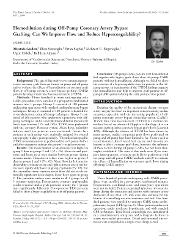| dc.contributor.author | Güden, Mustafa | |
| dc.contributor.author | Sanisoğlu, İlhan | |
| dc.contributor.author | Sağbaş, Ertan | |
| dc.contributor.author | Ergenoğlu, Mehmet U. | |
| dc.contributor.author | Özbek, Uğur | |
| dc.contributor.author | Akpınar, Belhhan | |
| dc.date.accessioned | 2019-06-27T08:00:58Z | |
| dc.date.available | 2019-06-27T08:00:58Z | |
| dc.date.issued | 2003 | |
| dc.identifier.issn | 1098-3511 | en_US |
| dc.identifier.uri | https://hdl.handle.net/20.500.12469/192 | |
| dc.description.abstract | Background: The aim of this study was to compare intraoperative coronary graft flows performed on pump and off pump and to evaluate the effects of hemodilution on coronary graft flows in off-pump coronary artery bypass grafting (CABG) patients by using transit time flow measurements (TTFM). Methods: Three hundred patients undergoing only CABG procedures were enrolled in a prospective randomized manner into 3 groups. Group 1 consisted of 100 patients undergoing operations with standard cardiopulmonary bypass techniques. Group 2 consisted of 100 patients scheduled for revascularizations using off-pump techniques. Group 3 consisted of 100 patients who underwent operations with off-pump techniques under controlled hemodilution (hematocrit levels kept between 25% and 28%). TTFM were performed with the coronary Flometer system. Mean flows pulsatility indices and flow patterns were evaluated. Twenty-five patients in each group were randomly assigned for control angiography 6 days postoperatively. Thromboelastographic (TEG) measurements were performed for each patient before and after surgery to evaluate the patient's coagulation status. Results: The mean number of anastomoses was higher in group 1 than in groups 2 and 3 (P < .05). Mean arterial pressures and heart rates were similar between groups during measurements. Hematocrit values were higher in group 2 than in groups 1 and 3 (P < .05). Mean flows for left anterior descending coronary artery and right coronary artery territories were significantly lower in group 2 patients (P < .05). For the circumflex artery territory mean flows did not reach statistically significant levels despite lower flows again in group 2. The pulsatility indices were similar in all 3 groups for all 3 coronary territories. Postoperative coronary angiographic results revealed similar graft patencies among the 3 groups (not significantly different). Postoperative TEG patterns failed to show a hypercoagulable state in off-pump patients. Conclusion: Off-pump CABG patients with hemodilution had significantly higher graft flows than off-pump CABG patients without hemodilution. Although we failed to show the existence of a hypercoagulable state for patients in the off-pump group an examination of the TTFM findings suggests that hemodilution may help to improve graft patency in off-pump CABG patients during the early postoperative period. | en_US] |
| dc.language.iso | eng | en_US |
| dc.publisher | Forum Multimedia Publishing LLC. | en_US |
| dc.rights | info:eu-repo/semantics/openAccess | en_US |
| dc.subject | N/A | en_US |
| dc.title | Hemodilution during off-pump coronary artery bypass grafting: Can we improve flow and reduce hypercoagulability? | en_US |
| dc.type | article | en_US |
| dc.identifier.startpage | 399 | en_US |
| dc.identifier.endpage | 402 | |
| dc.relation.journal | Heart Surgery Forum | en_US |
| dc.identifier.issue | 5 | |
| dc.identifier.volume | 6 | en_US |
| dc.identifier.wos | WOS:000185916500031 | en_US |
| dc.identifier.scopus | 2-s2.0-0142217336 | en_US |
| dc.institutionauthor | Güden, Mustafa | en_US |
| dc.institutionauthor | Sanisoğlu, İlhan | en_US |
| dc.relation.publicationcategory | Makale - Uluslararası Hakemli Dergi - Kurum Öğretim Elemanı | en_US |
| dc.identifier.pmid | 14721820 | en_US |
















